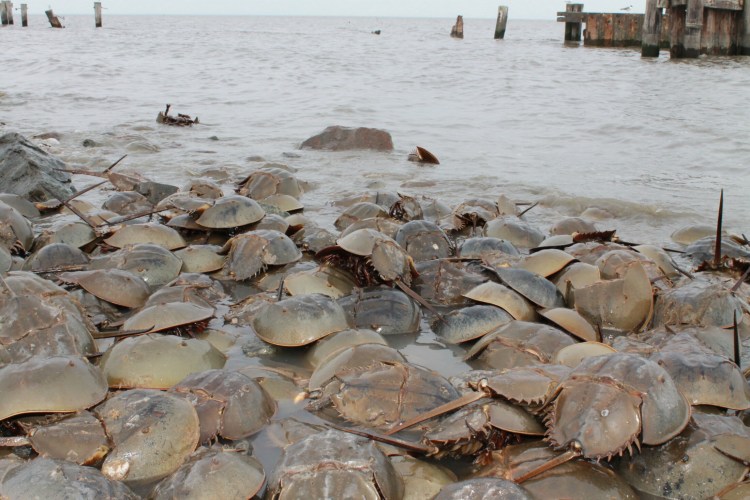Strange dark shapes were scuttling around on the sandy bottom. I watched them from the wharf at Chebeague Island with my little 8-year-old hands gripping the splintery planking and my face stuck out over the edge, looking down into the water. They glided around in gangs.
Horseshoe crabs, they were called, which puzzled me, the way you’re not sure what to think when someone tells you the stray bright star at Orion’s foot is a dog’s shoulder. It does not look like a dog. In the beginning, anyway. Horseshoe crabs were shaped only vaguely like horseshoes and definitely were not crabs, which run sideways on dangerous-looking legs and do not have tails like big stingers.
That was more than a half-century ago. Now I clearly see a dog bounding along behind Orion, and Limulus polyphemus’ rounded, double-ridged shell is close enough to horseshoe-shape that the common name seems right. But the deeper they get in time, the stranger they seem.
For one thing, they have a lot of eyes. Seven are on the shell – two on the back, similar in structure to human eyes; two “median” eyes toward the front, with another just behind them; and two on the sides that are used by the embryo inside its egg.
Underneath, near the mouth and legs at the middle of body, are two more eyes. And simple photoreceptors are arranged along the top of the tail, or telson.
The three eyes toward the front of the shell can pick up ultraviolet light, which humans can’t see. And they have special sensitivity to moonlight, apparently in use during spawning times, which peak on the evening high tides of full and new moons in May and June.
A horseshoe crab’s nervous system includes millions of sensory receptors all over its body, especially in the eight legs and two chelicerae (the small crablike claws that place food in their mouths), which can detect the chemical composition of the water.
More strangely, horseshoe crabs have no immune system. In other words, they don’t produce antibodies to fight infections. Instead, they make chemicals that inactivate bacteria and viruses, and that create clots to seal out further intruders. Horseshoe crab blood is used in serums and vaccines. Studies of their eyes turned into a Nobel prize in medicine in 1967.
Their hard shells led early biologists to classify them as crabs, but it’s been suspected for decades that horseshoe crabs are more closely related to spiders than they are to lobsters and crabs. They’re the only marine animals known to breathe with book lungs, similar to those of spiders. And in fact, a recent genetic study established that horseshoe crabs are, in fact, arachnids, meaning they’re aquatic evolutionary cousins of spiders, ticks and mites, and now classified as a sister group to hooded tick spiders (aka ricinuleids, spiderlike relatives of ticks and mice).
Strangeness and age play tricks with your memory. It seems as though, back there when I was 8 and gazing down into the water, I already knew horseshoe crabs are among the most ancient of still-living beings. The earliest horseshoe crab fossil is about 445 million years old, which means they scuttled across the floors of Earth’s silent seas roughly 350 million years before any flower blossomed. They are the closest living relatives of the trilobites, who flourished during that first evolutionary explosion of multi-celled animals about 530 million years ago. Horseshoe crabs survived the mass extinctions on Earth 250 million and 66 million years ago. The future, however, is not so sure. Their populations are declining up and down the East Coast, mainly because of pollution, coastal development, and effects of climate change such as sea level rise and warming water. The Maine Wildlife Action Plan lists them as a Priority 1 Species of Greatest Conservation Need.
I wasn’t thinking about conservation when I was 8. But the memory burned into my mind of them slipping across the floor of Chandler’s Cove suggests I expected they’d been here forever. And would be, like ancient starlight.
Dana Wilde lives in Troy. You can contact him at naturalist1@dwildepress.net. His recent book is “Summer to Fall: Notes and Numina from the Maine Woods,” available from North Country Press. Backyard Naturalist appears the second and fourth Thursdays each month.
Send questions/comments to the editors.



Success. Please wait for the page to reload. If the page does not reload within 5 seconds, please refresh the page.
Enter your email and password to access comments.
Hi, to comment on stories you must . This profile is in addition to your subscription and website login.
Already have a commenting profile? .
Invalid username/password.
Please check your email to confirm and complete your registration.
Only subscribers are eligible to post comments. Please subscribe or login first for digital access. Here’s why.
Use the form below to reset your password. When you've submitted your account email, we will send an email with a reset code.